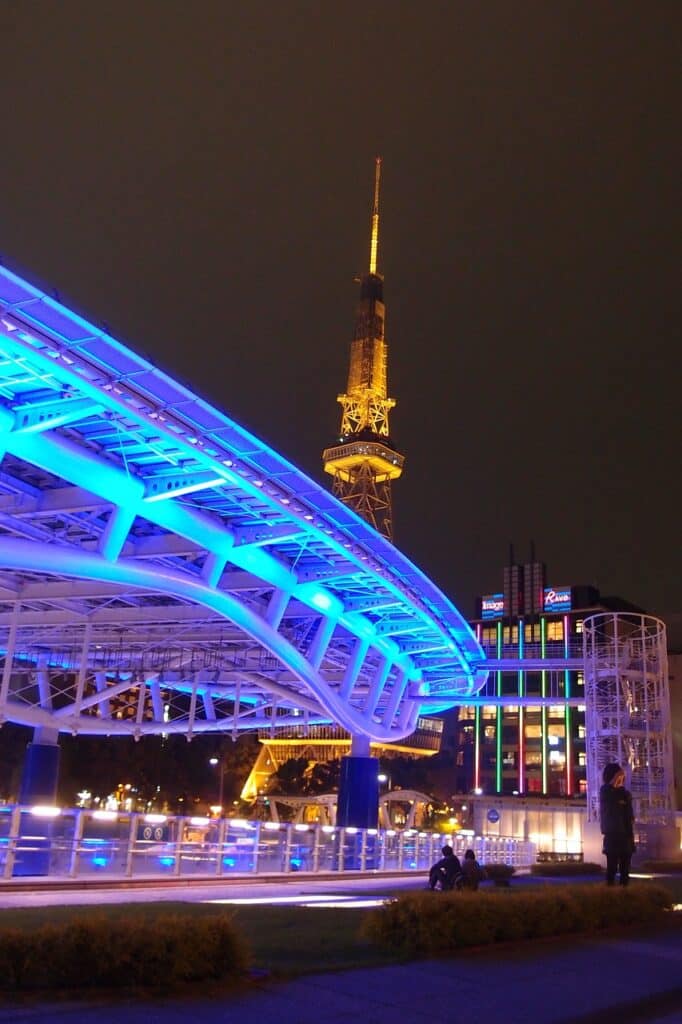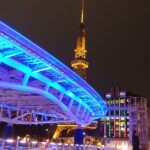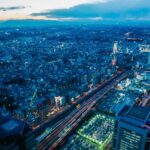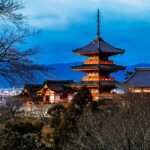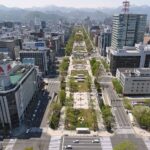Nagoya is a thriving metropolis with a comprehensive network of public transportation options. There are 6 lines that make up the Nagoya City Subway, the primary mode of public transportation in the city. The Meitetsu train network and a plethora of bus lines also provide service to the larger Nagoya area. A tram system provides convenient access to the city’s central business district. With these options, seeing the sights of the city is a breeze.
Subway system in Nagoya – Lines
The Nagoya Metro system has a total of 87 stations, and operates from 5am to midnight daily. In addition, the metro system is well-connected with the JR Central Lines and other train lines, providing easy access to other parts of the city.
Higashiyama Line (LINE 1) – yellow – “H”
Line 1 of the Nagoya City Rapid Railway is formally known as the Nagoya-shi Ksokudo Tetsud Dai-ichi-g-sen (Nagoya City Rapid Railway Line 1). It begins in Takabata in Nagoya’s Nakagawa Ward and ends in Fujigaoka in the city’s Meit Ward. Stations along the Higashiyama Line are denoted by a “H” and a number, and the line itself is depicted on maps in Windsor yellow. The contactless smart card, manaca, can be recharged at any station. This route connects Nagoya Station to Sakae, the city center. The result is the line’s strong popularity among commuters in Nagoya. All announcements are made in five languages: Japanese, English, Korean, Chinese, and Portuguese upon arrival, departure, and transfer between Nagoya and Fujigaoka stations.
Meijō Line (Line 2) – Purple – “M”
Located entirely within Nagoya, the line travels in a loop from Kanayama to Sakae, to Nagoya Daigaku, and back to Kanayama. On maps, the Meijō Line appears as a shade of wisteria purple. It uses a “M” prefix for all of its station numbers. The western half of the line is officially known as Line 2 of the Nagoya City Rapid Railway, while the eastern half is known as Line 4. The contactless smart card, manaca, can be recharged at any station. After the Toei edo Line, this is Japan’s second subway loop. However, the edo Line is not a genuine loop line because trains departing from the western Hikarigaoka terminus travel counterclockwise around the loop, stopping at Tochmae Station, and then returning to Hikarigaoka. This means the Meijō Line is the country’s first (and only) subway line with a genuine loop configuration. Compared to the JR Yamanote Line 34.5 km, this one is shorter, but it’s still longer than the JR saka Loop Line (21.7 km or 13.5 km). The total time to do the loop is 48 minutes. The shortened kanji for Nagoya Castle is where the name Meijō comes from.
Meijō Line (Line 2) – Purple – “E”
Located entirely within Nagoya, it travels between the Naka Ward’s Kanayama Station and the Minato Ward’s Nagoyako Station. On maps, the Meikō Line appears as a narrow band of wisteria purple and white. The route is officially known as Rapid Railway Line 2, which serves the city of Nagoya. The line connects directly to the Meijō Line.
Meitetsu Inuyama Line (Line 3) – Blue – “E”
Runs from Biwajima Junction in Kiyosu to Shin-Unuma station in Kakamigahara and is 26.8 kilometers in length. This line, along with the Meitetsu Kakamigahara Line, provides an alternative connection between Higashi-Biwajima and Meitetsu Gifu on the Meitetsu Nagoya Main Line.
Tsurumai Line – Pale Blue – “T”
It begins in Nishi-ku, Nagoya, in Kami Otai, and ends in Akaike, Nisshin. On maps, the Tsurumai Line appears as a pale blue line. The Inuyama Line, Toyota Line, and Mikawa Line are three of the Meitetsu lines with which this one connects directly. As of right now, it’s the only line that can take you beyond Nagoya proper.
The Meitetsu Toyota Line
Operated by the private railway operator Meitetsu (Nagoya Railroad), spans a distance of 15.2 kilometers between Umetsubo station in Toyota and Akaike station in Nisshin, Aichi Prefecture, Japan. At Akaike, the line connects directly to the Nagoya Subway’s Tsurumai Line.
The Meitetsu Mikawa Line
Spans 39.8 kilometers between Sanage Station in Toyota and Hekinan Station in Hekinan in Aichi Prefecture, Japan. Its intended reach was from Hekinan to Kira Yoshida and from Sanage to Nishi Nakagane; a planned expansion to Asuke had major construction completed but was ultimately scrapped (for further background, see the History section below). There are no express trains on this line; all trains are local and stop at each station. There may be only one platform and no passing loop at some of the smallest stations.
Sakura-dōri Line (Line 6) – Red – “S”
It travels within Nagoya, beginning at Taiko-dori Station in Nakamura Ward and ending in Tokushige in Midori Ward. The names of stations are listed on the new signage, followed by a single letter and a number. The official name of this line is Line 6 of the Nagoya City Rapid Railway. The contactless smart card, manaca, can be recharged at any station. As a Higashiyama Line bypass, it passes beneath Sakura-dōri Avenue between Nagoya and Imaike. When I first moved to Nagoya in 1995, this line was the only one of the city’s subways that ran on automatic trains. Each station can accommodate a train of up to 8 vehicles, however only 5 are used.
Meitetsu Komaki Line – Pink – “E”
Private railway line in Aichi Prefecture, Japan, running from Kamiiida Station in Nagoya to Inuyama Station in Inuyama over a distance of 20.6 kilometers. The majority of the line between Kamiiida and Ajima is underground, and it is a continuation of the Nagoya Municipal Subway’s Kamiiida Line.
Kamiiida Line – Light pink – “K”
It connects Nagoya’s Kita Ward’s Kamiiida and Heian-dri stations. Both of these stations’ platforms have self-closing gates. Line 7 of the Nagoya City Rapid Railway is the official name of the route. The route is a natural continuation of the existing Meitetsu Komaki route. This means that there is communication between the two lines. Kamiiida Station, the end of the Meitetsu Komaki Line, was cut off from the rest of the rail network when the Nagoya Municipal Tramway was eliminated in the 1970s. Users could either take a bus to Heian-dri Station or a long walk.
Map of Nagoya Metro 2024 – Free Download in PDF

Click and download the map of Nagoya’s underground system for 2024
With the introduction of the new Metro Map in 2024, the Nagoya Metro is expected to become even more easily accessible and efficient than it already is. Download this free PDF map of the Nagoya Metro system, which shows the location of all of the system’s important stations and connections. It will be helpful for locals and tourists alike to have such a comprehensive guide to the city at their fingertips. The Nagoya Metro Map 2024 is a must-have for any visitor due to its user-friendly design and straightforward presentation.
Public transport tickets – actual prices
The Nagoya metro Ticket, which is good for unlimited rides on all metro lines for one day, is a popular choice among both visitors and locals. The price of an adult ticket is 800 yen, while a child’s ticket is 400 yen. You can switch between metro lines with the same ticket.
The Nagoya Sightseeing Ticket is a good choice if you want to see as much as possible while in the city. Free rides on all metro and tram lines, free entrance to select attractions, and discounts at participating merchants are all part of this ticket. The price of an adult ticket is 1,500 yen, while a child’s ticket is 750 yen.
The Nagoya Grutto Pass is the best option for people who will be in the city for at least a few days. Free travel on all subway and tram lines, free entry to over 20 attractions, and discounts at select shops and restaurants are all part of this pass. Prices for adults are 2,200 yen and children’s are 1,100 yen for two days of use.
Finally, the 3-Day Tourist Pass is a good choice if you’ll only be in Nagoya for a few days. Unlimited trips on all metro and tram lines, as well as discounts at certain retailers and restaurants, are included in the price of this pass, which is 2,300 yen for adults and 1,150 yen for children.
The Nagoya 3-Day Tourist Pass is the ideal option for visitors staying for three days because it allows unlimited use of all metro and tram lines and discounts at participating shops and restaurants. This pass is an excellent choice for seeing all that Nagoya has to offer.
Timetables & Schedules of Nagoya subway
Every day from 5:00 AM until 12:00 AM, some lines of the Nagoya Metro system stop running. The frequency of train service is three to five minutes during rush hours and ten to fifteen minutes during non-peak times. Some trains run even more often on weekends and holidays. It’s crucial to prepare ahead if you want to use the Metro because the first and last trains on each line are different. For those who need to get around late at night, the Metro system also offers night buses and cabs.
Other Forms of Public Transportation In Nagoya
The metro isn’t the only kind of public transit available in Nagoya, Japan. The Aonami Line is a commuter railway, and the Meguru Bus is a sightseeing bus for tourists. In addition, the Port Liner, a boat service, runs from downtown Nagoya to the port area, as do several local bus routes and airport shuttles. These options are available to help you navigate Nagoya with ease.
public bus transportation
More than 500 buses serve more than 60 routes in the Nagoya public bus system, which is managed by the Nagoya City Transportation Bureau. The majority of the buses have air conditioning, making them a pleasant mode of transportation around the hot and humid city.
There are five different types of bus routes: regular, express, highway, overnight, and special. Local buses are the most popular and convenient way to travel within the city. These buses operate on set schedules, making numerous stops at convenient locations all across town.
The express buses travel to areas outside the city limits directly and are a little faster than the regular buses. It’s common practice for these buses to charge a premium. Highway buses offer the quickest method to get to nearby large cities and are the best choice for getting around town.
There are overnight buses that provide direct service to major cities across the country, making them a perfect alternative for budget-conscious vacationers. Last but not least, the region’s smallest communities are served by buses operating on unique routes.
Meitetsu Bus lines provide transportation to many different areas of Nagoya and are among the city’s most used bus services. The 1, 4, 7, 10, 11, 12, 13, and 14 bus routes see the largest ridership. These buses run regularly to numerous city destinations, including shopping malls, tourist hotspots, and major transit terminals.
Different types of sightseeing buses offer guided tours around Nagoya in addition to the regular buses. Taking one of these buses is a fantastic opportunity to see the sights and learn about the culture and history of the city.
public TRAINS
Public transportation in Nagoya is extensive because it is one of the largest cities in Japan. The city’s convenient accessibility is due in large part to the extensive railway network. Here, we’ll walk you through the ins and outs of Nagoya’s public railway system and highlight some of the city’s most vital rail links to neighboring metropolises.
Both the Meitetsu Railway and the JR Central Japan Railway operate Nagoya’s public transportation system. The Meitetsu Railway serves central Nagoya and its suburbs, while the JR Central line operates between Tokyo and Osaka and serves long-distance passengers. In addition, the private Kintetsu Railway also serves the region.
The Meitetsu Railway makes getting around the city center of Nagoya quick and painless. There are a number of lines that run around the city, linking key stops such Nagoya Station, Sakae Station, and Kanayama Station. Lines on the Meitetsu Railway connect to nearby cities such Toyohashi, Gifu, and Inuyama.
Meanwhile, the JR Central line connects Nagoya to both Tokyo and Osaka, making it the primary long-distance railway in Japan. Connectivity to neighboring cities like Shizuoka, Yokkaichi, and Toyama is another perk of this route.
Nagoya provides visitors with a number of passes that can be used on the city’s extensive subway and subway system. The JR Central Rai Pass is valid for seven days of unlimited travel on the JR Central line, while the Meitetsu Rail Pass is valid for one day of unlimited travel on any Meitetsu line in the city.
To sum up, Nagoya has an excellent public train system. The JR Central line provides long-distance rail links to Tokyo and Osaka, while the Meitetsu Railway’s many lines connect the city’s important stations. Visitors to the city can save time and money by purchasing a pass good for unlimited rides on both the Meitetsu and JR Central lines.
From Chubu Centrair International Airport (NGO) To The City Center With Public Transport
Public transportation in Nagoya is extensive because it is one of the largest cities in Japan. The city’s convenient accessibility is due in large part to the extensive railway network. Here, we’ll walk you through the ins and outs of Nagoya’s public railway system and highlight some of the city’s most vital rail links to neighboring metropolises.
Both the Meitetsu Railway and the JR Central Japan Railway operate Nagoya’s public transportation system. The Meitetsu Railway serves central Nagoya and its suburbs, while the JR Central line operates between Tokyo and Osaka and serves long-distance passengers. In addition, the private Kintetsu Railway also serves the region.
The Meitetsu Railway makes getting around the city center of Nagoya quick and painless. There are a number of lines that run around the city, linking key stops such Nagoya Station, Sakae Station, and Kanayama Station. Lines on the Meitetsu Railway connect to nearby cities such Toyohashi, Gifu, and Inuyama.
Meanwhile, the JR Central line connects Nagoya to both Tokyo and Osaka, making it the primary long-distance railway in Japan. Connectivity to neighboring cities like Shizuoka, Yokkaichi, and Toyama is another perk of this route.
Nagoya provides visitors with a number of passes that can be used on the city’s extensive subway and subway system. The JR Central Rai Pass is valid for seven days of unlimited travel on the JR Central line, while the Meitetsu Rail Pass is valid for one day of unlimited travel on any Meitetsu line in the city.
To sum up, Nagoya has an excellent public train system. The JR Central line provides long-distance rail links to Tokyo and Osaka, while the Meitetsu Railway’s many lines connect the city’s important stations. Visitors to the city can save time and money by purchasing a pass good for unlimited rides on both the Meitetsu and JR Central lines.
how to spend 3 days in Nagoya?
Is this your first time thinking about visiting Nagoya? Want to learn about the fascinating history, indulge in the delectable cuisine, and party the night away? Then you can stop your search right here, because we have the ideal three-day plan for you.
On your first day in Nagoya, take in as much of the local heritage as possible. The Nagoya Castle is an excellent starting point for the day because it is such a beautiful representation of classic Japanese architecture. Take the time to hike up to the top of the castle for a breathtaking panorama of the surrounding area. After that, stop by the Osu Kannon Temple, which features a one-of-a-kind souvenir market. Following that, you can explore the stores, cafés, and bars of the nearby Osu Shopping Arcade.
On your second day in Nagoya, you should devote your time to sampling the city’s delectable fare. The best way to kick off the day is with a trip to the morning market, where you can stock up on fresh, regional fare. Then, dine at a well-known Furukawa Honten, known for its excellent Miso Katsu and other local specialties. The Kanayama Fish Market is the place to purchase some of the city’s freshest seafood for lunch. The day should culminate with a trip to Sakae District, which features some of the city’s finest dining establishments.
On the third day of your trip, you may experience the vibrant nightlife of Nagoya. You may get your night started at any of the many bars or clubs in the Oasis 21 complex. Then, check out the live music at Tower Records. Stop by one of the city’s top nightclubs, Club Mago, before calling it a night.
This concludes your three-day plan for seeing the sights of Nagoya. With this strategy, you can make the most of your stay in this vibrant metropolis. Enjoy!
What other metro systems are nearby to Nagoya?
Japan is renowned for its efficient and extensive subway systems, with the most significant ones being in Tokyo, Osaka, and Kyoto. The Tokyo Metro is considered the most significant, comprising 9 lines and catering to approximately 6.84 million passengers daily. It is not only one of the busiest but also one of the most comprehensive subway systems globally. The Osaka Metro, on the other hand, is the second-largest subway system in Japan, featuring 8 lines and serving more than 2 million passengers daily. It is celebrated for its punctuality and cleanliness. Kyoto, although smaller compared to Tokyo and Osaka, also has a reliable subway system with two lines. These subway systems play a crucial role in the country’s transportation network, contributing significantly to its economy and the daily lives of its citizens.
CHECK OUT THIS AWESOME VIDEO TOUR GUIDE
Summary of our tour guide for Nagoya
Having spent the last five years in Nagoya, I am very familiar with the city’s public transportation system. Traveling around the city and seeing all it has to offer is a breeze thanks to the convenient public transportation system. Long or short, the public transit system will get you where you need to go at a price that won’t break the bank. One of the things I enjoy most about living in Nagoya is how easy and quick it is to navigate around the city.
Top 5 FAQs and answers about Nagoya public transport?
- Where can I find information about Nagoya’s public transportation options?
- Buses, subways, trains, and trams are all part of Nagoya’s large public transportation network. There are a variety of taxi and ride-hailing options available in the city as well.
- How much does it cost to take the bus around Nagoya?
- Nagoya’s public transportation prices change based on the mode of travel. The city’s ticketing system is unified, so you may buy one ticket and use it for many rides. The average cost of a single fare is from $200 to $250.
- How can I buy a ticket for the Nagoya subway?
- Buying an IC card is the most common way to ride the subway or bus in Nagoya. In order to pay for rides on buses, subways, and trains, passengers can utilize prepaid IC cards.
- How do I use the city’s public transportation to reach where I need to go?
- Nagoya’s public transportation system is simple to navigate. There are numerous options for public transportation inside the city, including buses, subways, trains, and trams. You can utilize tools like internet maps and navigation applications to help you identify the most efficient paths.
- I was wondering whether there were any Nagoya public transportation discounts available.
- Using the city’s public transportation can save you money in various ways, and that’s true in Nagoya. Students and seniors receive discounts in this city, and those who plan to take numerous trips at once might save money by purchasing them together.
Useful links

